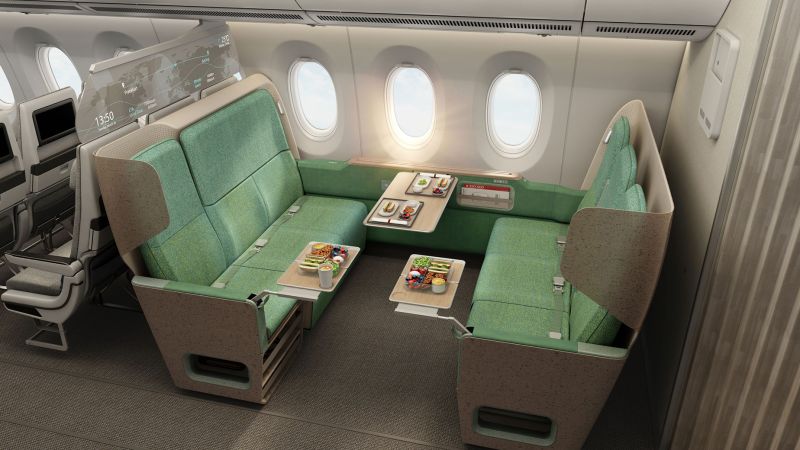Editor’s Note: Sign up for Unlocking the World, CNN Travel’s weekly newsletter. Get the latest news in aviation, food and drink, where to stay and other travel developments.
Hamburg, Germany
CNN
—
From an economy cabin concept allowing rows of fliers to sit opposite one another to a wellbeing area designed to keep travelers moving on ultra-long-haul flights. Welcome to the future of aviation – at least according to the 2024 Crystal Cabin Awards.
Each year, this top aviation prize spotlights innovation in airplane cabin interiors – with nominees ranging from ready-to-launch, airline-backed initiatives, to experimental and as-yet-unrealized designs.
This year’s longlist included eye-catching concept Ameco’s Fly-Buddy Hub, described by the company as a “versatile social hub” that rearranges two rows of the economy cabin so that six passengers can sit facing one another.

After whittling down the longlist to a shortlist earlier this year, 28 industry experts crowned the eight winners at this year’s ceremony, held at the Aircraft Interiors Expo in Hamburg, Germany.
Among this year’s winners was Diehl Aviation for its Wellbeing Zone, designed in partnership with Qantas for the airline’s upcoming “Project Sunrise” ultra-long-haul flights, set to connect Sydney to London and New York via 19-hour-plus journeys.
Diehl and Qantas’ design triumphed in the “passenger comfort” category, imagining a roomy area between the A350 premium economy and economy cabins, offering space for passengers to stretch their legs, grab a snack and get moving as they cross time zones.

Caroline Oxley, who works for the Crystal Cabin Award Association, tells CNN Travel this year’s finalists share a “more democratic approach” to improving the passenger experience.
She notes Diehl and Qantas’ Wellbeing Zone is a concept more commonplace in business class and first class, but Diehl and Qantas’ vision is designed to benefit those with the cheapest seats on the plane.
Also aiming to ameliorate the flying experience across the board is the winner of the “health and safety” category, Accenture GmbH’s “Accenture PED safety bag.” This concept aims to tackle growing concerns around lithium battery fires on airplanes – should a personal device catch alight, this bag should safely contain flames for up to six hours. Oxley calls the design “absolutely convincing.”
Similarly making waves in the “health and safety” category was nominee AirPRO by Schroth Safety Products, who presented a passenger lap belt airbag developed in collaboration with the design studio Teams and DesignBüro Stühmer/Scholz. Paired with crash sensor technology installed under the airplane seat, the bag’s designed to be activated quickly in an emergency to help protect travelers from injury.
The Crystal Cabin Awards also seeks to spotlight ideas that could make aviation more environmentally sound, with Oxley suggesting “hands-on solutions” triumphed.
This year’s winner of the “sustainable cabin category” was Diehl Aviation for their “ECO Sidewall” – a greener take on an airplane wall. Also shortlisted in this category was RECARO Aircraft Seating’s R Sphere, which intriguingly imagines airplane seats made from sustainable materials such as recycled fishing nets and cactus. RECARO claims this 100% recyclable seat could reduce CO2 emissions by 63 tonnes per aircraft per year.
Meanwhile Crystal Cabin’s “university” award highlights the next generation of airplane innovation, and is “intended to provide a forum for particularly creative designs,” as the Crystal Cabin Awards Association puts it. This year’s winner was Tongji University in Shanghai, awarded for its “Flexifold” seat – which aims to increase flexibility with an easily adaptable economy seat concept.

Other notable nominees in the university category include the University of Sao Paulo in Brazil, which worked in cooperation with aircraft manufacturer Embraer to design an aircraft-wide noise-canceling device, rendering the wearing of individual headphones obsolete. The futuristic concept uses artificial intelligence and an on-board camera to direct sound waves at passengers’ heads and subsequently reduce the noisy whirring of the aircraft engines.
Meanwhile the University of Virginia Tech worked with Boeing, All Wheels Up and Collins Aerospace on its Wheelchair Space and Securement System (WSSS). This hook-based device works to allow wheelchair users to stay in their wheelchairs for the duration of the flight. This design’s now the basis of Collins Aerospace’ wheelchair aircraft solution – on display at this year’s Aircraft Interiors Expo and attracting a lot of industry buzz.
Winner Cabin Concepts: Factorydesign, Coop. BermudAir “The BermudAir Aisle Class Suite”
Winner Material and Components: Collins Aerospace “STARLight”
Winner Cabin Systems: Safran Cabin “theCUBE”
Winner Health & Safety: Accenture GmbH “Accenture PED safety bag”
Winner Passenger Comfort: Diehl Aviation, Coop. Qantas Airways Ltd “The Wellbeing Zone”
Winner IFEC and Digital Services: Thales Avionics “FlytEdge”
Winner Sustainable Cabin: Diehl Aviation “ECO Sidewall”
University winners: Tongji University, Coop. Dupont “Flexifold”

